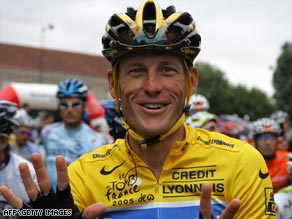
American cyclist Lance Armstrong suffered a shattering blow in his comeback bid on Monday when he broke his right collarbone after falling on the first stage of a five-day race in northern Spain.
Doctors were determining whether the record seven-time Tour de France champion would need surgery said Jacinto Vidarte, spokesman for the Vuelta Ciclista Castilla y Leon race. Armstrong could be out three to four weeks, Vidarte added, following a crash that involved a group of 15 to 20 riders some 20 kilometers from the finish. The 37-year-old Armstrong was taken to a hospital by ambulance and was seen pointing to his collarbone, CNN’s Al Goodman reported from northern Spain. Armstrong, who came out of retirement after more than three years to return to competitive cycling with Astana in January, walked to the ambulance unaided, television pictures from the scene showed. Bartosz Huzarski, a cyclist racing for the Italian team ISD, saw the fall, but said he did not know what had caused it. Only Armstrong appeared to indicate he was hurt, the Polish cyclist said. The fall took place a on a sunny day on a stretch of two-lane highway, Goodman said, as riders tackled the 104-mile (168-km) opening stage, as Armstrong stepped up his latest return to the sport. Armstrong’s first comeback came in 1998, two years after he was diagnosed with advanced testicular cancer that had spread to his lungs and brain. Doctors gave him a less than 50 percent chance of survival. He has become a highly visible cancer activist at the head of his Livestrong foundation. Armstrong, whose Tour triumphs came between 1999-2005, announced in September last year that he would be returning to the saddle. He launched his comeback in January when he raced in the Tour Down Under in Australia, finishing 29th. Armstrong then played a key support role as Astana teammate Levi Leipheimer won the Tour of California title in February before finishing 125th in last Saturday’s Milan-San Remo in Italy. He was riding in this week’s Castilla and Leon race to continue his bid to reach peak form ahead of the Giro d’Italia and then a crack at an eighth Tour crown. Armstrong returned to the sport not only to attempt to become the oldest Tour winner, but also to raise awareness about cancer.
“The most important issue is taking the global epidemic of cancer really to a much bigger stage,” explained Armstrong, who previously fought a battle with testicular cancer. “The best way to do that is to race the bike all over the world. So you race in Australia, South Africa, South America, Europe, America — that is the first priority,” added the Texan.